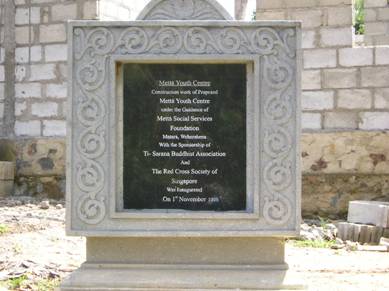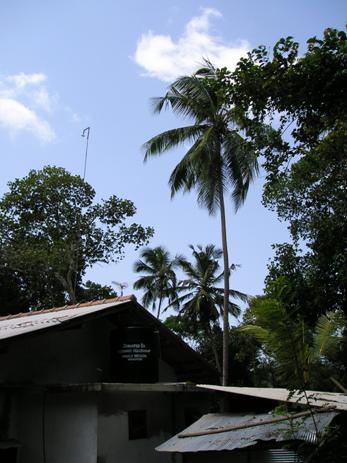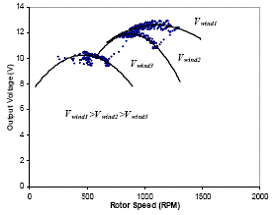SUSTAINABLE ENERGY SYSTEMS DESIGN FOR A TRIBAL VILLAGE IN INDIA
Impact/Purpose:
Our project aims to sustainably meet the energy needs of more than
1000 villagers in the Narmada River Valley in Maharashtra, India, where a series
of large dams are displacing more than one million indigenous people from their
homes and land. The two principal features of our project are:
a) Developing an integrated energy system for the village integrating energy
supply from various renewable resources with benign energy storage options
in order to meet multiple energy uses such as home-lighting, home-cooking and
community refrigeration;
b) Working with the community and our Indian partners to develop and field-test
collaborative designs of the integrated energy system and its various components.
Attaining P3 Goals in Developing Nations: By using renewable energy resources,
energy efficiency models and benign energy storage options, our project addresses
environmental- and ecosystem- sustainability. By working closely with the community
and through collaborative US-India design workshops, the energy systems developed
in this work use low-cost local materials and indigenous skills, addressing
socio-cultural and economic aspects of sustainable development.
Description:
Lab testing and limited field testing revealed the effectiveness of the following products designed in this study:
o Hand-made anemometers – Several hand-made anemometers with low-cost data logging devices (bicycle odometers) were constructed by the University of Colorado Team to be put in place at the field site. The devices were designed to record wind speed data in areas with no access to electricity or computers, and worked effectively for periods of 6 months or more. Local Buddhist monks were able to monitor wind speed data effectively using these devices.
o Local Knowledge: Innovative local design was integrated to build an anemometer tower that used the hollow of an old banyan tree to erect the anemometer to more than a height of 80 feet.
o
o UCD Wind Turbine Construction and Testing: Three different wind generator designs of different size were constructed and tested at UCD laboratories. A small Universal Axis Helical Turbine and various Vertical Axes Wind Turbines, were operated for direct DC current generation, and for water pumping. Various low-cost materials and designs were explored and energy production measured using fan blower testing. Costs ranged from $20 for the UAHT suited for operating small LED lamps generating about 10W at 15 miles per hour, to $1000 for a large VAWT operated for pumping water that achieved an efficiency of ~6%. Designs were developed for larger Horizontal Axes Wind Turbines (HAWT) with hand-carved wooden blades 6 feet, 8 feet and 10 feet in diameter, a major accomplishment as available hand-made wind turbine designs were previously only available for 6 feet diameter wooden blades. Based on cost effectiveness, the 10 foot blade HAWT design (costing about $2000 USD) was chosen for the field with an expected power output of about 1kW at 15 mph winds.
o Charge Controller: Low-cost charge controllers were designed and built by undergraduate electrical engineering students at UC Denver and mechanical engineering students at Colorado State University, as part of their senior design classes. The charge controllers were designed to maximize electricity production from wind and storage in batteries. They also served as over-speed control shutting down the wind turbines at high rpm. The cost of the charge controllers was estimated at $50 if mass-produced versus commercially available models at the time that cost about $500.
These charge controllers are being tested for long-term durability and performance for a period of 1 year as required by testing standards. Figures and photos of these activities are shown on the next page.
In Year 2, a hybrid wind-solar field system was designed for the site in Sri Lanka by electrical engineering professor Dr. Fernando Mancilla. Based on the power needs of the dormitory, and an estimate of the hours of power use, a 3.2 kW system was designed to provide end-use of 10 kWh per day for one dormitory as shown below, assuming 5 hours of wind/sun, and 30% line losses.
Implementation is contracted to Vence – a licensed electrical installations corporation in Sri Lanka, who in-charge of the final field installation at a total cost of $36,000, including costs of purchasing and importing solar panels and batteries from Singapore.
3. On The Ground Community and Environmental Impacts
The following social, environmental and economic sustainability benefits are calculated from a 10 kWh/day (3.2MW) operating renewable energy system on site:
- Socially, the system will provide power to residential dormitories housing 50 girls and boys orphaned by the tsunami of 2004, who have lost both parents. The renewable energy installation at the Metta Youth Center (MYC) provides an important social service to the area.
- Economic Benefits: Funds for operating the dormitory at the MYC were provided by the Red Cross of Singapore for the first year. Sustaining dormitory operations is now possible because of the renewable energy system installed though this P3 project that will save MYC Rupees 15.5 per kWh for a 10 kWh per day system, yielding annual savings of about USD 550 per year to the MYC. Additional savings through possible Clean Development Mechanism were also explored and found to be small.
- Environmental Benefits: The primary environmental benefit of this project is CO2, SOX and NOx reduction from reducing emissions from grid-electricity. With line losses in excess of 20% and a CO2e displaced factor of 0.8 kg/kWh, a 10kWh per day renewable electricity supply will displace 2.5 metric tones of CO2e per year over the life of the project.
|
Metta Youth Center (MYC) dormitory in construction at Matara, Sri Lanka.
|
|

|
|
|
Test bed results from testing the wind generator charge controller for peak power tracking (Gitano et al., 2007)
|
|
Anemometer Installed for Wind Data Logging to a height of 80 feet
4. Educational Impacts at UCD
This P3 project was integrated into UCD’s Civil Engineering Systems – Sustainable Infrastructure curriculum in three major ways:
- A new course titled “Field Methods for Sustainable Development” was developed by Professor Ramaswami, in which tools for site assessment and infrastructure design are discussed.
- Two small renewable energy exhibits have been constructed by Professors Mancilla and Grabbe for students to gain hands-on experience with wind and solar energy, respectively. One includes a smaller wind generator on UCD’s roof, and a small solar photovoltaic system – a web cam will be installed in Spring 2009 to create a ‘Wind Generator On the Web” exhibit.
- Three MS students have completed MS Reports on various sub components of this project.
- Charge Controller design and testing has been part of the senior design classes of Mechanical Engineering students at Colorado State University and Electrical Engineering students at UC Denver.
Student feedback on the role of this project in their learning of fieldwork for sustainability has been very positive.
Leverage of Funding: This EPA P3 project (Phase 1 and Phase 2) leveraged an additional $10,000 from the First Data Western Union Foundation for sustainable and humanitarian work in Asia. With a grant proposal to the Department of Energy, Dr. Mancilla seeks to further develop small wind generator testing in the US.
Record Details:
Record Type:PROJECT(
ABSTRACT
)
Start Date:09/01/2005
Completion Date:08/31/2006
Record ID:
142950
Keywords:
DEVELOPING NATIONS, ENERGY EFFICIENCY, BENIGN ENERGY STORAGE, RENEWABLE
RESOURCES, SOLAR ENERGY, WIND ENERGY, ZEOLITE REFRIGERATOR, BIOGAS, HYDROGEN
STORAGE, WIND TURBINES,
Related Organizations:
Role
:OWNER
Organization Name
:COLORADO STATE UNIVERSITY
Citation
:Ft Collins
State
:CO
Zip Code
:80523
Role
:OWNER
Organization Name
:UNIVERSITY OF COLORADO AT DENVER
Mailing Address
:P.O. Box 173364 Campus Box 151
Citation
:Denver
State
:CO
Zip Code
:80217
Project Information:
Approach
:Building upon work accomplished in Phase 1 of this
project, this phase will focus on: a) Field testing of three different scales
and designs of wind generators for energy supply; b) Field trials of low-cost
energy-efficient LED lighting units; c) Lab-scale and field testing of a community
solar-zeolite refrigerator; d) Pilot demonstrations of home-scale wind turbines
integrated with cook stoves for electricity; e) Lab scale exploration with
selected pilot-demonstrations of three high impact energy storage ideas: spring
storage for the home-scale wind generators, biogas generation-utilization in
2 stroke engines for community-scale work applications, hydrogen generation
from wind resources with storage and electricity regeneration, suited for rural
applications. Metrics for design success include performance, cost, adoption
rate in communities, avoided fossil fuel use and air quality improvements.
P3 Project as an Educational Tool: This project will be employed in graduate
and undergraduate-level education through the Global Engineering Program at
CSU and through PLaCES student group at UCD.
Cost
:$75,000.00
Research Component
:Pollution Prevention/Sustainable Development
Approach
:Building upon work accomplished in Phase 1 of this
project, this phase will focus on: a) Field testing of three different scales
and designs of wind generators for energy supply; b) Field trials of low-cost
energy-efficient LED lighting units; c) Lab-scale and field testing of a community
solar-zeolite refrigerator; d) Pilot demonstrations of home-scale wind turbines
integrated with cook stoves for electricity; e) Lab scale exploration with
selected pilot-demonstrations of three high impact energy storage ideas: spring
storage for the home-scale wind generators, biogas generation-utilization in
2 stroke engines for community-scale work applications, hydrogen generation
from wind resources with storage and electricity regeneration, suited for rural
applications. Metrics for design success include performance, cost, adoption
rate in communities, avoided fossil fuel use and air quality improvements.
P3 Project as an Educational Tool: This project will be employed in graduate
and undergraduate-level education through the Global Engineering Program at
CSU and through PLaCES student group at UCD.
Cost
:$75,000.00
Research Component
:P3 Challenge Area - Energy
Project IDs:
ID Code
:SU832464
Project type
:EPA Grant



